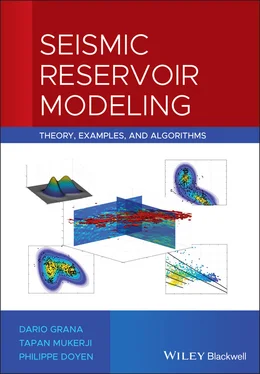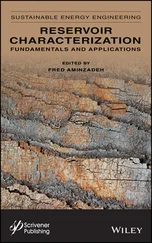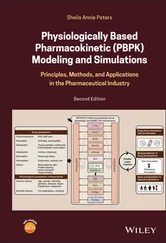1 Cover
2 Title Page
3 Copyright Page
4 Dedication Page
5 Preface
6 Acknowledgments
7 1 Review of Probability and Statistics 1.1 Introduction to Probability and Statistics 1.2 Probability 1.3 Statistics 1.4 Probability Distributions 1.5 Functions of Random Variable 1.6 Inverse Theory 1.7 Bayesian Inversion
8 2 Rock Physics Models 2.1 Rock Physics Relations 2.2 Effective Media 2.3 Critical Porosity Concept 2.4 Granular Media Models 2.5 Inclusion Models 2.6 Gassmann's Equations and Fluid Substitution 2.7 Other Rock Physics Relations 2.8 Application
9 3 Geostatistics for Continuous Properties 3.1 Introduction to Spatial Correlation 3.2 Spatial Correlation Functions 3.3 Spatial Interpolation 3.4 Kriging 3.5 Sequential Simulations 3.6 Other Simulation Methods 3.7 Application
10 4 Geostatistics for Discrete Properties 4.1 Indicator Kriging 4.2 Sequential Indicator Simulation 4.3 Truncated Gaussian Simulation 4.4 Markov Chain Models 4.5 Multiple‐Point Statistics 4.6 Application
11 5 Seismic and Petrophysical Inversion 5.1 Seismic Modeling 5.2 Bayesian Inversion 5.3 Bayesian Linearized AVO Inversion 5.4 Bayesian Rock Physics Inversion 5.5 Uncertainty Propagation 5.6 Geostatistical Inversion 5.7 Other Stochastic Methods
12 6 Seismic Facies Inversion 6.1 Bayesian Classification 6.2 Bayesian Markov Chain Gaussian Mixture Inversion 6.3 Multimodal Markov Chain Monte Carlo Inversion 6.4 Probability Perturbation Method 6.5 Other Stochastic Methods
13 7 Integrated Methods 7.1 Sources of Uncertainty 7.2 Time‐Lapse Seismic Inversion 7.3 Electromagnetic Inversion 7.4 History Matching 7.5 Value of Information
14 8 Case Studies 8.1 Hydrocarbon Reservoir Studies 8.2 CO 2Sequestration Study
15 Appendix: MATLAB Codes A.1 Rock Physics Modeling A.2 Geostatistical Modeling A.3 Inverse Modeling A.4 Facies Modeling
16 References
17 Index
18 End User License Agreement
1 Chapter 2 Table 2.1 Density, bulk modulus, and shear modulus of quartz, clay, calcite, ... Table 2.2 Density and bulk modulus of water, oil, and gas. The ranges of valu...
2 Chapter 6Table 6.1 Absolute frequencies of the facies classification.Table 6.2 Reconstruction rate of the facies classification.Table 6.3 Recognition rate of the facies classification.Table 6.4 Estimation index of the facies classification.
1 Chapter 1 Figure 1.1 Bar chart of the probability mass function of a discrete random v... Figure 1.2 Graphical interpretation of the probability P (2 < X ≤ 3) of a con... Figure 1.3 Comparison of statistical estimators: mean (square), median (circ... Figure 1.4 Multivariate probability density functions: bivariate joint distr... Figure 1.5 Bayes' theorem: the posterior probability is proportional to the ... Figure 1.6 Examples of different correlations of the joint distribution of t... Figure 1.7 Uniform probability density function in the interval [1, 3]. Figure 1.8 Standard Gaussian probability density function with 0 mean and va... Figure 1.9 Log‐Gaussian probability density function associated with the sta... Figure 1.10 Univariate Gaussian mixture probability density function, with t... Figure 1.11 Bivariate Gaussian mixture probability density function estimate... Figure 1.12 Beta probability density function in the interval [0, 1]: the so...
2 Chapter 2 Figure 2.1 Han's dataset: P‐wave velocity versus porosity color coded by cla... Figure 2.2 Wyllie and Raymer's equations as a function of porosity for clay ... Figure 2.3 Voigt, Reuss, and Voigt–Reuss–Hill averages for the bulk and shea... Figure 2.4 Hashin–Shtrikman elastic bounds for the bulk and shear moduli of ... Figure 2.5 Fluid mixing laws for a mixture of water and gas: the dashed line...Figure 2.6 Soft sand and stiff sand models for the bulk and shear moduli of ...Figure 2.7 Inclusion models for the bulk and shear moduli of a porous rock m...Figure 2.8 Application of Gassmann's equations and fluid substitution to a s...Figure 2.9 P‐wave and S‐wave velocity predictions as a function of porosity ...Figure 2.10 P‐wave and S‐wave velocity predictions as a function of porosity...Figure 2.11 P‐wave and S‐wave velocity variations as a function of effective...Figure 2.12 Well logs for the Weber Sandstone formation, from left to right:...Figure 2.13 Stiff sand rock physics model for the Weber Sandstone formation:...Figure 2.14 Well logs for the Madison Limestone formation, from left to righ...Figure 2.15 Berryman's inclusion rock physics model for the Madison Limeston...
3 Chapter 3Figure 3.1 Three different porosity profiles: profile 1 shows the original d...Figure 3.2 Histograms of porosity profiles in Figure 3.1, showing a similar ...Figure 3.3 Cross‐plots of pairs of porosity samples measured at gradually in...Figure 3.4 Experimental vertical correlation functions for porosity profiles...Figure 3.5 Example of experimental vertical correlation function and corresp...Figure 3.6 Spatial covariance functions and corresponding variogram models w...Figure 3.7 Ellipse representing the azimuth‐dependent correlation length and...Figure 3.8 Schematic representations of four data configurations. The dots r...Figure 3.9 Spatial configuration and covariance model used for the kriging s...Figure 3.10 Elevation and temperature maps of Yellowstone National Park. The...Figure 3.11 Simple kriging estimate maps of elevation and corresponding krig...Figure 3.12 Cokriging estimate maps of elevation and corresponding cokriging...Figure 3.13 Cokriging estimate maps of elevation and corresponding cokriging...Figure 3.14 Schematic representation of sequential Gaussian simulation for a...Figure 3.15 Three random sequential Gaussian simulation realizations and the...Figure 3.16 Three random sequential Gaussian simulation realizations and the...Figure 3.17 Comparison of simple kriging and sequential Gaussian simulation ...Figure 3.18 Three random sequential Gaussian co‐simulation realizations and ...Figure 3.19 Application of geostatistical sequential simulations to reservoi...Figure 3.20 Application of geostatistical sequential simulations to reservoi...
4 Chapter 4Figure 4.1 Peak–valley classification map of elevation data in the Yellowsto...Figure 4.2 Maps of indicator kriging probability of peaks and corresponding ...Figure 4.3 Schematic representation of sequential indicator simulation for a...Figure 4.4 Three random sequential indicator simulation realizations and the...Figure 4.5 Three random sequential indicator co‐simulation realizations and ...Figure 4.6 Three random truncated Gaussian simulation realizations and the a...Figure 4.7 Facies simulations obtained using a stationary first‐order Markov...Figure 4.8 Schematic representation of ENESim and SNESim algorithms for a tw...Figure 4.9 Training image and three multiple‐point statistics random realiza...Figure 4.10 Application of sequential Gaussian mixture simulation to reservo...
5 Chapter 5Figure 5.1 Well log data from a borehole in the Norwegian Sea: P‐wave veloci...Figure 5.2 Synthetic seismic data for three partial angle stacks: near (12°)...Figure 5.3 Bayesian linearized AVO inversion results: posterior distribution...Figure 5.4 Examples of Gaussian mixture models: a bivariate joint distributi...Figure 5.5 Petrophysical curves computed from well log data in Figure 5.1, m...Figure 5.6 Bayesian linearized rock physics inversion results: posterior dis...Figure 5.7 Bayesian non‐linear and non‐parametric rock physics inversion res...Figure 5.8 Uncertainty propagation (Gaussian mixture case): posterior distri...Figure 5.9 Uncertainty propagation (non‐parametric case): posterior distribu...Figure 5.10 Prior ensemble of petrophysical properties: porosity, clay volum...Figure 5.11 Posterior ensemble of petrophysical properties: porosity, clay v...Figure 5.12 Posterior ensemble of elastic properties: P‐wave velocity, S‐wav...
Читать дальше












